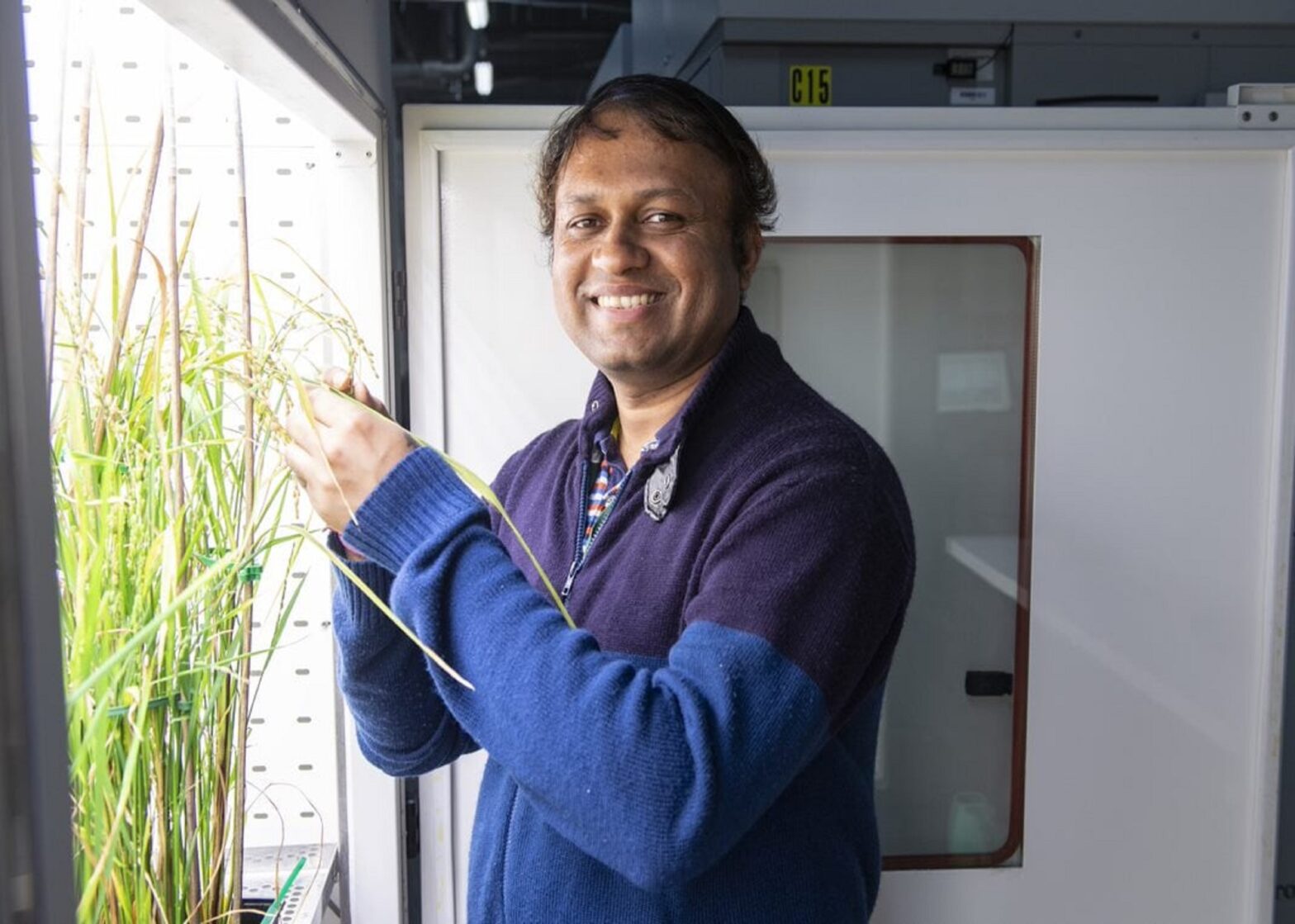
Dr. Rupam Kumar Bhunia
About
My research focuses on plant biotechnology and, more specifically, metabolic engineering of lipid biosynthetic pathways for improved lipid traits in plants. My academic career to date has been at the intersection of plant biotechnology and biochemistry. I received my Ph.D. in plant biotechnology from the Indian Institute of Technology (IIT), Kharagpur on enhancement of omega-3 fatty acid in sesame oil. I did my post-doctoral research at Iowa State University, USA on establishing the structure of cutin (surface lipid). I received the prestigious DST-INSPIRE faculty award and worked on seed lipid rancidity at National Agri-Food Biotechnology Institute (NABI), Mohali. I received the Rothamsted International fellowship from Rothamsted Research, UK, where we utilized “SDN-1” genome editing to switch on (transcriptional gain-of-function) a gene in plant. My current research interests focus on the area of plant metabolic networks, with the aim of applying my expertise to alleviate societal identified challenges and establishing a career that can utilize these insights to increase crop sustainability (or “LIPIDS of Crops”).
Background
Education:
- 2023 : Associate Fellow at TERI, New Delhi, India.
- 2018-2022 : DST-INSPIRE Faculty at NABI, Mohali, India.
- 2021-2022. : Rothamsted International Fellow, Rothamsted Research, UK.
- 2015-2017 : Post-doctoral Research Associate at Iowa State University, USA.
- 2015 : PhD at Indian Institute of Technology (IIT), Kharagpur, India.
Honours and Awards
- 2021 Best Publication Award (Agri-Biotechnology), NABI, India.
- 2021 Rothamsted International Fellowship, Rothamsted Research, UK.
- 2018 DST-INSPIRE Faculty, DST, India.
- 2013 BioAsia Innovation Award, BioAsia, Hyderabad, India.
- 2013 Best Poster Presentation, National Symposium on Plant Tissue Culture and Biotechnology for Food and Nutritional Security, CFTRI, Mysore, India.
Research Group Overview
My current research interest revolves around developing strategies to improve shelf-life of seed lipids, which if achieved, can significantly aid in the development and use of high quality, nutritious bran oil and millet products. Lipases that contribute to seed lipid rancidity have been identified. We aim to down-regulate those lipases in a target-specific manner by using genome editing tools to overcome the issue of rancidity. My research also focuses on improving edible oil quality. Oils high in oleic acid are desirable for their cooking and health benefits. The fatty acid desaturase (FAD2) enzyme, which converts oleic acid (18:1) to linoleic acid (18:2), appears to be a critical determinant of oleic acid content and thus a prime target for the creation of high oleic germplasms via FAD2 gene mutations or suppression. Each approach has inherent limitations on plant performance. As a result, we aim to increase the oleic acid content in Indian oil seed mustard using a novel CRISPR-Cas9-based strategy that involves a stable reduction of FAD2 expression in seeds without compromising plant health. See more for the strategy:
https://www.rothamsted.ac.uk/news/scientists-turn-gene-without-creating-gmo;
Publications
Five highly cited articles:
1.Aher R, Reddy PS#, Bhunia RK#, Flyckt K, Shankhpal AR, Ojha R, Everard JD, Wayne LL, Ruddy BM, Deonovic B, Gupta SK, Sharma KK and Bhatnagar-Mathur P (2022). Loss-of-function of triacylglycerol lipases are associated with low flour rancidity in pearl millet [Pennisetum glaucum (L.) R. Br.]. Frontiers in Plant Science 13:962667. https://doi.org/10.3389/fpls.2022.962667
2.Verma L, Bhadouria J, Bhunia RK, Singh S, Panchal P, Bhatia C, Eastmond P, and Giri J (2022). Monogalactosyl diacylglycerol synthase 3 affects phosphate utilization and acquisition in rice. Journal of Experimental Botany, 73:5033-5051. https://doi.org/10.1093/jxb/erac192
3.Bhunia RK, Menard G and Eastmond P (2022). A native promoter–gene fusion created by CRISPR/Cas9-mediated genomic deletion offers a transgene-free method to drive oil accumulation in leaves. FEBS letters, 596: 1865-1870. https://doi.org/10.1002/1873-3468.14365.
4.Menard GN, Langdon M, Bhunia RK, Shankhapal AR, Noleto-Dias C, Lomax C, Ward JL, Kurup S, and Eastmond PJ. (2022) Diverting phenylpropanoid pathway flux from sinapine to produce industrially useful 4-vinyl derivatives of hydroxycinnamic acids in Brassicaceous oilseeds. Metabolic Engineering, 70: 196-205. https://doi.org/10.1016/j.ymben.2022.01.016
5.Bhutada G, Menard G, Bhunia RK, Hapeta PP, Ledesma-Amaro R, Eastmond PJ (2022). Production of human milk fat substitute by engineered strains of Yarrowia lipolytica. Metabolic Engineering Communications, 14: e00192. https://doi.org/10.1016/j.mec.2022.e00192
6.Ojha R#, Kaur S#, Sinha K#, Chawla K, Kaur S, Jadhav H, Kaur M and Bhunia RK (2021). Characterization of oleosin genes from forage sorghum in Arabidopsis and yeast reveals their role in storage lipid stability. Planta, 254:97. https://doi.org/10.1007/s00425-021-03744-8
7.Sinha K, Kaur R, Singh N, Kaur S, Rishi V and Bhunia RK. (2020) Mobilization of storage lipid reserve and expression analysis of lipase and lipoxygenase genes in rice (Oryza sativa var. Pusa Basmati 1)bran during germination.Phytochemistry,180:112538. https://doi.org/10.1016/j.phytochem.2020.112538
8.Bhunia RK, Sinha K, Chawla K, Randhawa V and Sharma TR. (2020) Functional characterization of two type-1 diacylglycerol acyltransferase (DGAT1) genes from rice (Oryza sativa) embryo restoring the triacylglycerol accumulation in yeast. Plant Molecular Biology. 105:247–262. https://doi.org/10.1007/s11103-020-01085-w
9.Chawla K, Sinha K, Neelam, Kaur R, and Bhunia RK. (2020) Identification and functional characterization of two acyl CoA: diacylglycerol acetyltransferase 1 (DGAT1) genes from forage sorghum (Sorghum bicolor).Phytochemistry, 176:112405. https://doi.org/10.1016/j.phytochem.2020.112405
10.Bhunia RK, Showman L, Jose A and Nikolau B. (2018) Combined use of cutinase and high resolution mass-spectrometry to query the molecular structure of cutin. Plant Methods, 14:117. https://doi.org/10.1186/s13007-018-0384-6
# equal contribution

